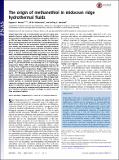| dc.contributor.author | Reeves, Eoghan | |
| dc.contributor.author | McDermott, Jill Marie | |
| dc.contributor.author | Seewald, Jeffrey S. | |
| dc.date.accessioned | 2014-11-04T15:43:33Z | |
| dc.date.available | 2014-11-04T15:43:33Z | |
| dc.date.issued | 2014-03 | |
| dc.date.submitted | 2014-01 | |
| dc.identifier.issn | 0027-8424 | |
| dc.identifier.issn | 1091-6490 | |
| dc.identifier.uri | http://hdl.handle.net/1721.1/91287 | |
| dc.description.abstract | Simple alkyl thiols such as methanethiol (CH[subscript 3]SH) are widely speculated to form in seafloor hot spring fluids. Putative CH[subscript 3]SH synthesis by abiotic (nonbiological) reduction of inorganic carbon (CO[subscript 2] or CO) has been invoked as an initiation reaction for the emergence of protometabolism and microbial life in primordial hydrothermal settings. Thiols are also presumptive ligands for hydrothermal trace metals and potential fuels for associated microbial communities. In an effort to constrain sources and sinks of CH[subscript 3]SH in seafloor hydrothermal systems, we determined for the first time its abundance in diverse hydrothermal fluids emanating from ultramafic, mafic, and sediment-covered midocean ridge settings. Our data demonstrate that the distribution of CH[subscript 3]SH is inconsistent with metastable equilibrium with inorganic carbon, indicating that production by abiotic carbon reduction is more limited than previously proposed. CH[subscript 3]SH concentrations are uniformly low (∼10[superscript −8] M) in high-temperature fluids (>200 °C) from all unsedimented systems and, in many cases, suggestive of metastable equilibrium with CH[subscript 4] instead. Associated low-temperature fluids (<200 °C) formed by admixing of seawater, however, are invariably enriched in CH[subscript 3]3SH (up to ∼10[superscript −6] M) along with NH[+ over 4] and low-molecular-weight hydrocarbons relative to high-temperature source fluids, resembling our observations from a sediment-hosted system. This strongly implicates thermogenic interactions between upwelling fluids and microbial biomass or associated dissolved organic matter during subsurface mixing in crustal aquifers. Widespread thermal degradation of subsurface organic matter may be an important source of organic production in unsedimented hydrothermal systems and may influence microbial metabolic strategies in cooler near-seafloor and plume habitats. | en_US |
| dc.description.sponsorship | Woods Hole Oceanographic Institution. Deep Ocean Exploration Institute | en_US |
| dc.description.sponsorship | InterRidge | en_US |
| dc.description.sponsorship | German Science Foundation (Cluster of Excellence) | en_US |
| dc.language.iso | en_US | |
| dc.publisher | National Academy of Sciences (U.S.) | en_US |
| dc.relation.isversionof | http://dx.doi.org/10.1073/pnas.1400643111 | en_US |
| dc.rights | Article is made available in accordance with the publisher's policy and may be subject to US copyright law. Please refer to the publisher's site for terms of use. | en_US |
| dc.source | PNAS | en_US |
| dc.title | The origin of methanethiol in midocean ridge hydrothermal fluids | en_US |
| dc.type | Article | en_US |
| dc.identifier.citation | Reeves, Eoghan P., Jill M. McDermott, and Jeffrey S. Seewald. “The Origin of Methanethiol in Midocean Ridge Hydrothermal Fluids.” Proceedings of the National Academy of Sciences 111, no. 15 (March 27, 2014): 5474–5479. | en_US |
| dc.contributor.department | Massachusetts Institute of Technology. Department of Earth, Atmospheric, and Planetary Sciences | en_US |
| dc.contributor.department | Woods Hole Oceanographic Institution | en_US |
| dc.contributor.mitauthor | Reeves, Eoghan | en_US |
| dc.contributor.mitauthor | McDermott, Jill Marie | en_US |
| dc.relation.journal | Proceedings of the National Academy of Sciences | en_US |
| dc.eprint.version | Final published version | en_US |
| dc.type.uri | http://purl.org/eprint/type/JournalArticle | en_US |
| eprint.status | http://purl.org/eprint/status/PeerReviewed | en_US |
| dspace.orderedauthors | Reeves, Eoghan P.; McDermott, Jill M.; Seewald, Jeffrey S. | en_US |
| mit.license | PUBLISHER_POLICY | en_US |
| mit.metadata.status | Complete | |
